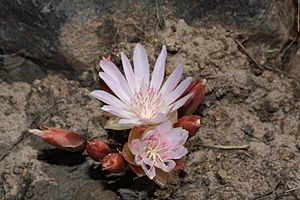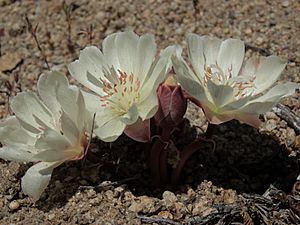Bitterroot facts for kids
Quick facts for kids Bitterroot |
|
|---|---|
 |
|
| Lewisia rediviva var. rediviva in Wenas Wildlife Area, Washington | |
| Scientific classification | |
| Genus: |
Lewisia
|
| Species: |
rediviva
|
The Bitterroot (Lewisia rediviva) is a small plant that lives for many years. It is a type of herb in the plant family called Montiaceae. Its scientific name, rediviva, means "revived" or "reborn." This name fits perfectly because the plant can grow back even from roots that look dry and dead.
The group of plants called Lewisia used to be in the purslane family. But in 2009, scientists moved them to the Montiaceae family. This change happened when a new way of classifying plants, called the APG III system, was adopted.
Contents
Where Does the Bitterroot Plant Grow?
The Bitterroot plant grows naturally in western North America. You can find it in grasslands, open bush areas, and forests. It likes dry, rocky, or gravelly soils.
Its home stretches from southern British Columbia in Canada. It goes through Washington and Oregon, east of the Cascade Range. It reaches southern California. To the east, it grows in western Montana, Wyoming, northern Colorado, and northern Arizona.
What Does the Bitterroot Plant Look Like?
The Lewisia rediviva is a low-growing plant. It has a thick root that stores food and water. Its flower stems are usually 1 to 3 centimeters (about 0.4 to 1.2 inches) tall. Each stem has a ring of 5 to 6 small leaves called bracts. These bracts are about 5 to 10 millimeters long.
Each stem grows a single flower. The flower has 5 to 9 oval-shaped sepals. These can be white, pink, or lavender in color. Bitterroot flowers bloom from April to July. The petals are long and thin, usually 18 to 35 millimeters (about 0.7 to 1.4 inches) long. There are usually about 15 petals on each flower. When the plant is mature, it makes small, egg-shaped seed pods. Each pod holds 6 to 20 round seeds.
The thick roots of the Bitterroot plant are ready to eat in late spring. People can peel them, boil them, and make them into a food that feels like jelly.
Bitterroot's Place in History and Culture
French fur trappers called this plant racine amère, which means "bitter root." Native American tribes had their own names for it. Some names included spetlum or sp̓eƛ̓m̓, meaning "hand-peeled." The Ktanxa people called it nakamtcu. The Cheyenne called it mo'ôtáa-heséeo'ôtse, meaning "black medicine."

Tribes like the Shoshone and the Flathead Indians ate the roots. It was often considered a special treat. Traditionally, the Ktunaxa people cooked bitterroot with grouse, a type of bird. The Ktunaxa often eat bitterroot with sugar. Other tribes prefer to eat it with salt. The Lemhi Shoshone believed a small red part inside the root had special powers. They thought it could even stop a bear attack.
Meriwether Lewis of the Lewis and Clark Expedition ate bitterroot in 1805 and 1806. He collected samples of the plant. A German-American botanist named Frederick Pursh later identified these samples. He gave the plant its scientific name, Lewisia rediviva, after Meriwether Lewis. Pursh thought Lewis had called it "spatlum" in his notes. But this was actually a Salishan name for "tobacco."
In 1895, the Bitterroot was chosen as the official state flower of Montana.
Three important places in Montana are named after this flower. The Bitterroot Mountains run north to south and separate Idaho and Montana. The Bitterroot Valley is a beautiful area. The Bitterroot River flows north and joins the Clark Fork River in Missoula. All these names come from the Bitterroot flower.
See also
 In Spanish: Lewisia rediviva para niños
In Spanish: Lewisia rediviva para niños


